Pennine Way Companion
Pennine Way Companion was published in June 1968 and was dedicated to:
“THE ONE WHO HELPED MOST OF ALL”
<<>>
While Wainwright is commonly linked with the Lake District, his profound connection with the backbone of northern England was equally noteworthy. His 1938 circular walk, A Pennine Journey, from Settle to Hadrian’s Wall, showcased his thorough exploration of this rugged terrain. Therefore, when Wainwright produced the Pennine Way Companion, his familiarity with this untamed landscape was well-established.

Wainwright’s name has become synonymous with Britain’s first official long-distance path (268 miles), even more so than Tom Stephenson, the walk’s creator. Stephenson campaigned for over thirty years to establish his ‘Long Green Trail,’ stretching from Edale in Derbyshire to Kirk Yetholm in the Scottish Borders. On 24 April 1965, the Pennine Way officially debuted as England’s inaugural National Trail, celebrated with a ceremony on Malham Moor.
Early guidebooks for the walk were difficult to follow, prompting Wainwright to create his own improved version. Recognising the magnitude of this task, he enlisted the help of four seasoned fellwalkers: Harry Appleyard, Len Chadwick, Cyril Moore, and Lawrence W. Smith. Each team member took responsibility for a specific section of the route. Wainwright dedicated the following year, from Easter 1966 to late 1967, to traversing and verifying every detail of each section.
Published in June 1968, the Pennine Way Companion was a resounding success. Its innovative design reads from the back to the front and bottom up. Although initially unconventional, readers quickly found it intuitive. During the 1970s, the guide’s popularity soared, outselling several of Wainwright’s Lakeland guides. For some, the promise of a free pint (now a half) at the Border Hotel, offered by Wainwright for completing the walk, was an enticing reward.
Today, with 16 National Trails to choose from, the Pennine Way may not be as highly regarded as it once was, but it remains a popular and challenging long-distance walk. The Spine Race, established in 2012, has further increased its popularity. With 2025 marking the trail’s 60th anniversary, the Pennine Way’s enduring appeal will undoubtedly see a new wave of walkers eager to celebrate this remarkable milestone.

Examining Wainwright’s guides reveals that not all his writings should be accepted at face value. His sense of humour, for instance, carries layers of interpretation. Wainwright emerges as a complex character, and it’s likely that only a select few truly understood the intricacies of his personality.
Wainwright candidly expressed his experience on the Pennine Way, which was marked by relentless, days-long driving rain. His straightforward account includes being stuck in a bog on the summit of Black Hill—an ordeal significant enough to discourage even the most resilient hiker.
The apparent loathing of the Pennine Way seemingly originated from Wainwright’s experience on the trail, but delving deeper unveils a more complex backdrop. During that period, he was experiencing personal pressures, including the evolving relationship with Betty McNally in late 1965. The subsequent year saw the dissolution of his marriage to Ruth, who initiated divorce proceedings. Wainwright’s contemplation of abandoning the book indicates complications in his personal life during that time.
Authors frequently infuse their writing with reflections of their lives at a particular moment, and Wainwright may have been no exception. His exploration of the Pennine Way and the turmoil in his private life raises the question of whether these experiences seeped into his writing. While it remains speculative, there is a compelling case to consider the intersection of Wainwright’s life and his narrative on the Pennine Way.
We will never really know for sure, and perhaps he meant what he said in his closing comment, “You won’t come across me anywhere along the Pennine Way. I’ve had enough of it.”
Betty played a crucial role in Wainwright’s research for the route, providing invaluable support with her car to transport him to remote trail locations. This facilitated a broader exploration for Wainwright, extending beyond the confines of the Cumbrian border. Grateful for her assistance, he expressed his thanks by dedicating the Pennine Way Companion to Betty.
The guide proved a resounding success for the Westmorland Gazette, surpassing the sales of many of his earlier Pictorial Guides by the mid-1980s. This achievement stands as a testament to its remarkable popularity.
<<>>
A First Edition is identified by:
- Turquoise case with round corners and gold blocking
- 18/- price on the dust jacket
- No impression number

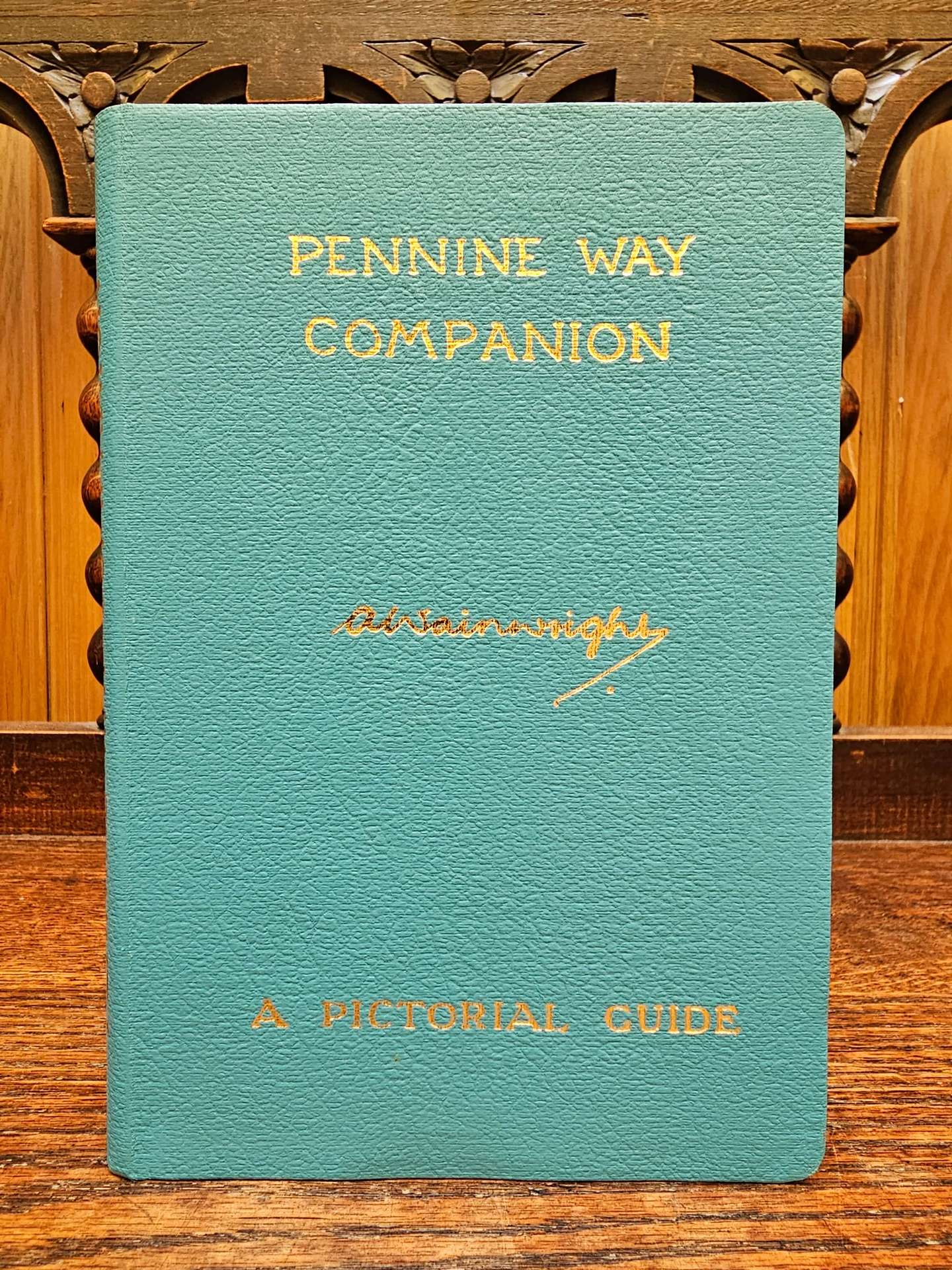

During the mid to late 1970s, the Gazette transitioned from Letterpress printing to adopting advanced offset litho technology. This upgrade not only enhanced print quality but also significantly reduced the overall printing time. The process involved creating negatives from the original pages, each with 16 images. Printing plates were then produced from the negatives. The final printed sheets were subsequently guillotined and prepared for folding.
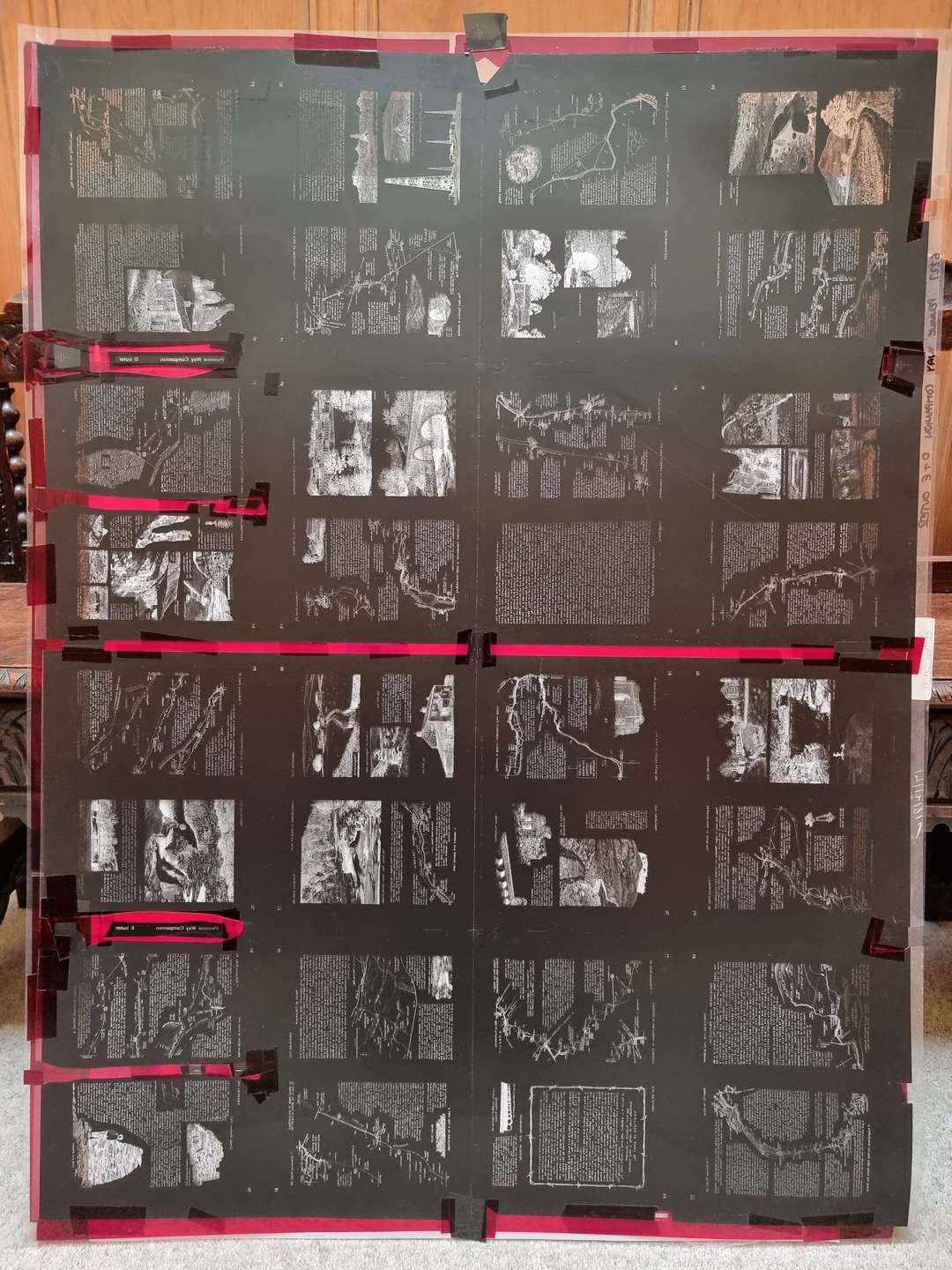




Dust jacket negatives were utilised over an extended period, with old prices either cut out and replaced or entirely masked. Presented here are surviving samples of the dust jackets that have endured over the intervening years.





This guide introduced an 18/- price printed directly on the dust jacket, differentiating it from the other Pictorial Guides where 18/- stickers were affixed over the old prices. This practice continued until new dust jackets were created, featuring the updated 18/- 90p price.
Tommy Fellowes assumed the responsibility of either price clipping or affixing new stickers. Having served as the storeman at the Gazette since the 1960s, he managed the packing of book orders and meticulously clipped and stickered thousands of dust jackets over the years. His dedicated efforts continued until his retirement in the 1980s.
Betty’s favourite colour, turquoise, initially graced the case but changed to blue before the end of 1970. The alteration also included squared corners on the case, streamlining production for increased efficiency and cost-effectiveness. Coinciding with the era of decimalisation, in 1971, the price of the Pennine Way Companion rose to £1.05.
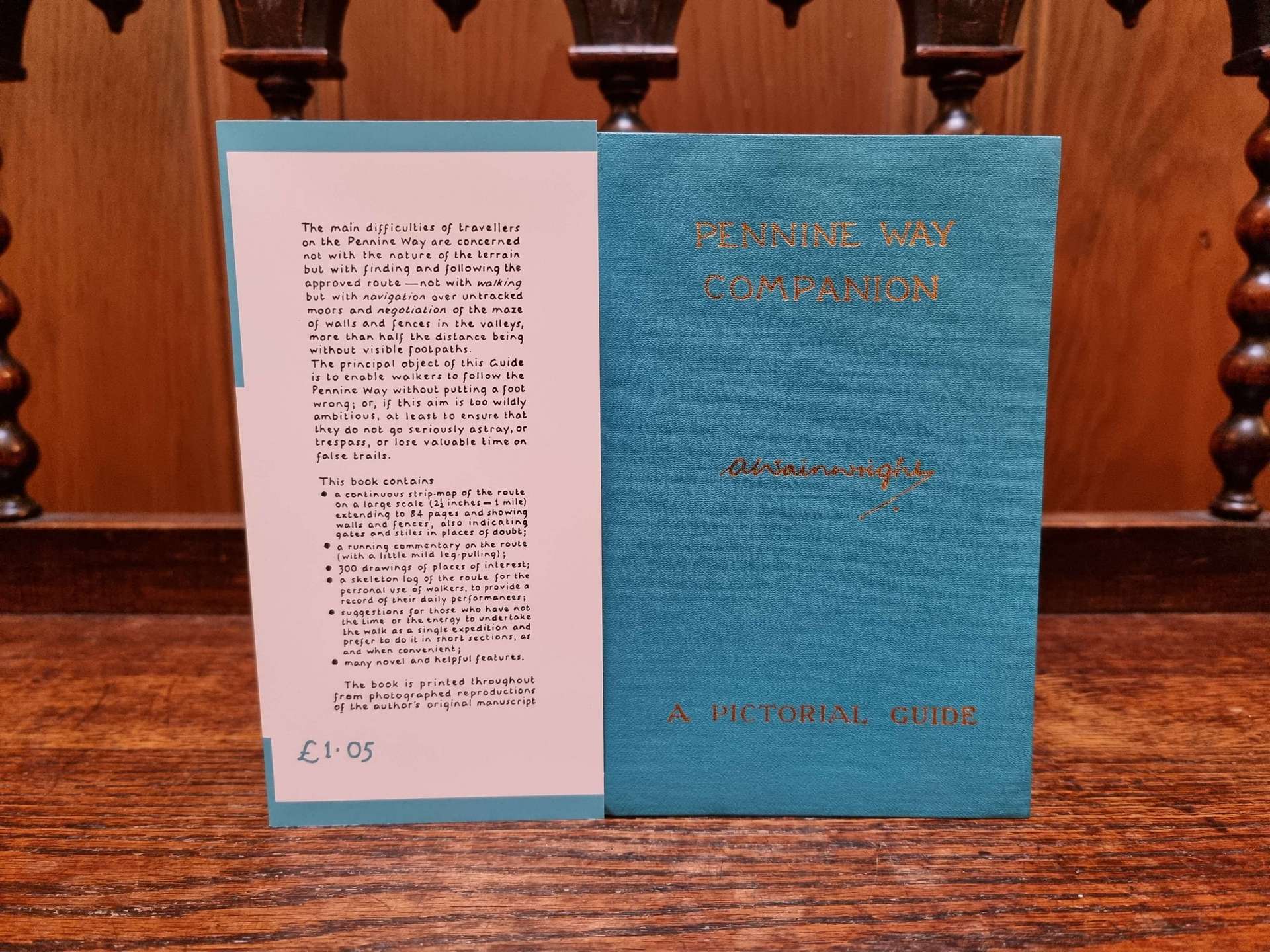


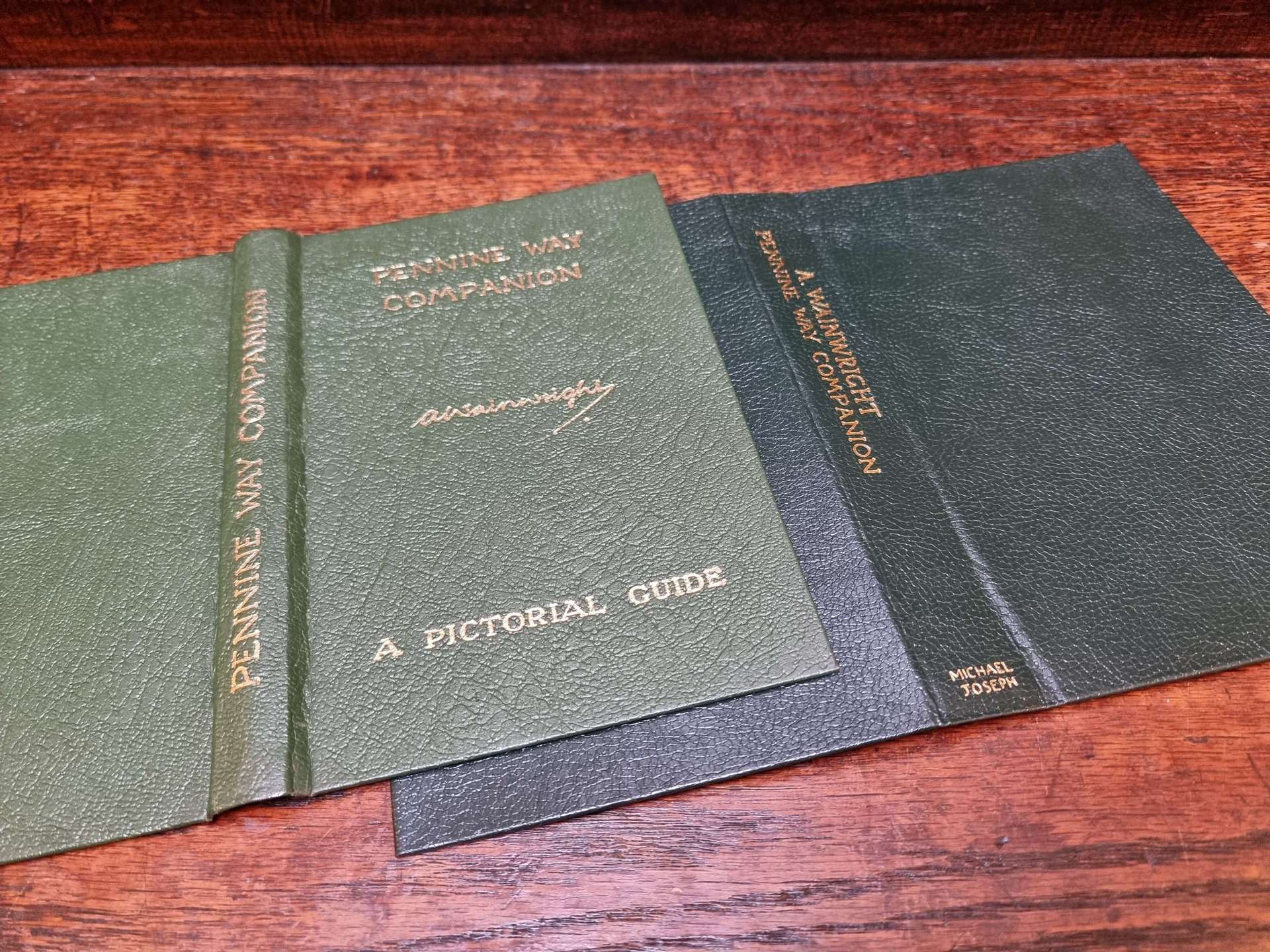

The Pennine Way’s route has changed over the years, influenced by factors such as path enhancements, erosion, and landowner requests. Some diversions have been implemented to showcase improved scenery and address various considerations. These alterations have prompted multiple revisions to the guide throughout its existence, aligning it with the evolving route of the Pennine Way.
Here are two instances where the guide stirred concerns. The initial letter outlines a complaint lodged with the Gazette regarding a remark made by Wainwright in the guide. Although there was a threat of legal action against the publisher, no such proceedings materialised, as there was no substantive case. The description in the guide remained unaltered for another two decades.

The second letter originates from the Peak District National Park, diplomatically proposing a minor route adjustment to enhance walker safety during shooting days. Wainwright graciously acknowledged their concern and consented to the modification. He promptly revised the page, incorporating these changes into the sixty-fourth impression approximately three years later.

In the 1970s, many guides sharing the same impression number featured different case types due to shortages in certain materials. In cases where specific materials were scarce, alternative cases were employed. Below are two fifty-ninth impression guides from 1979, each displaying distinct case variations.
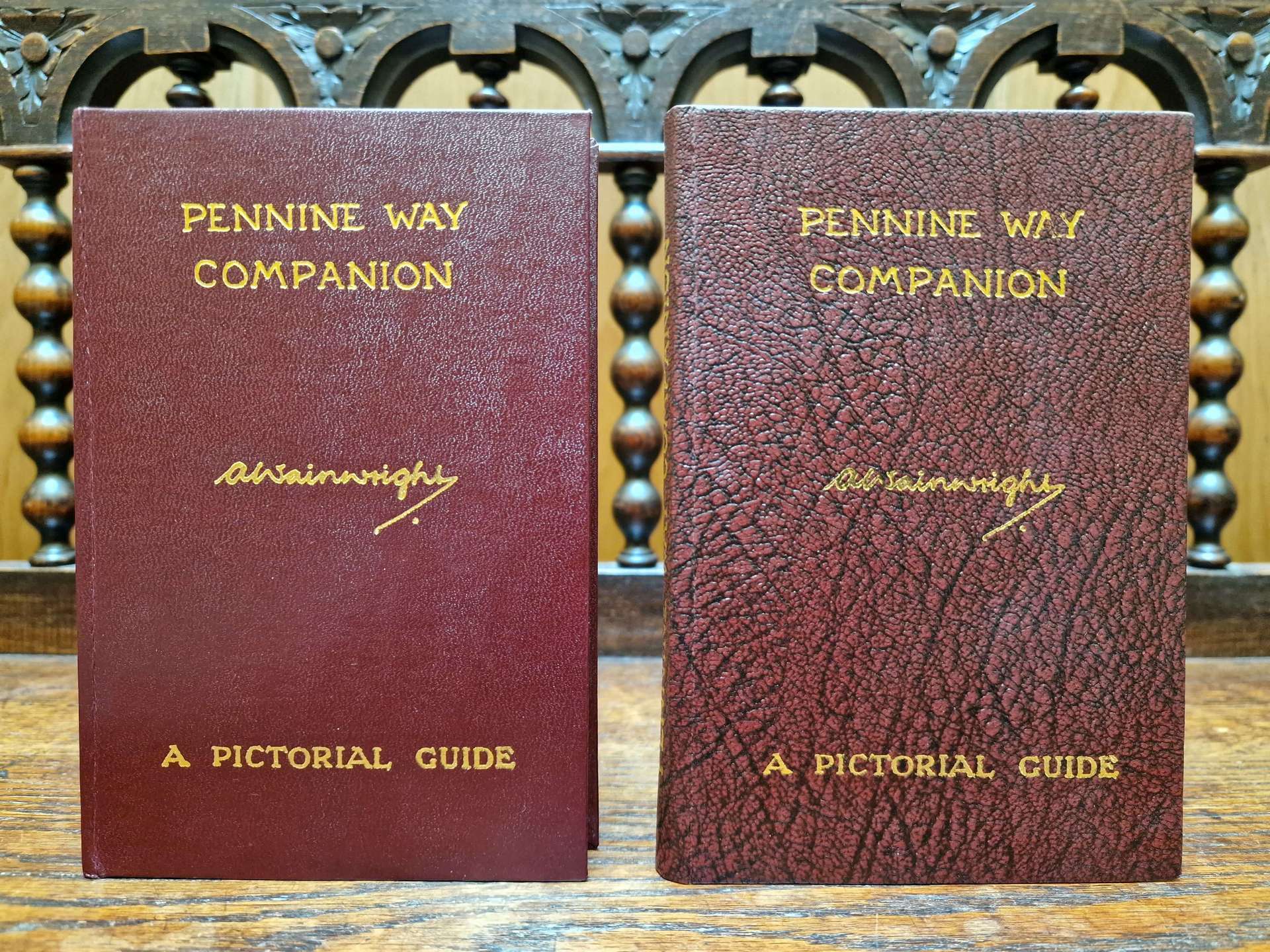

The early 1980s marked significant changes for the guides. Removing gold blocking from the front of the case and discontinuing impression numbers were notable adjustments for efficiency and cost savings. These alterations were implemented even after the Pennine Way Companion reached its eighty-sixth impression, underscoring the guide’s popularity two decades after the trail’s official opening.

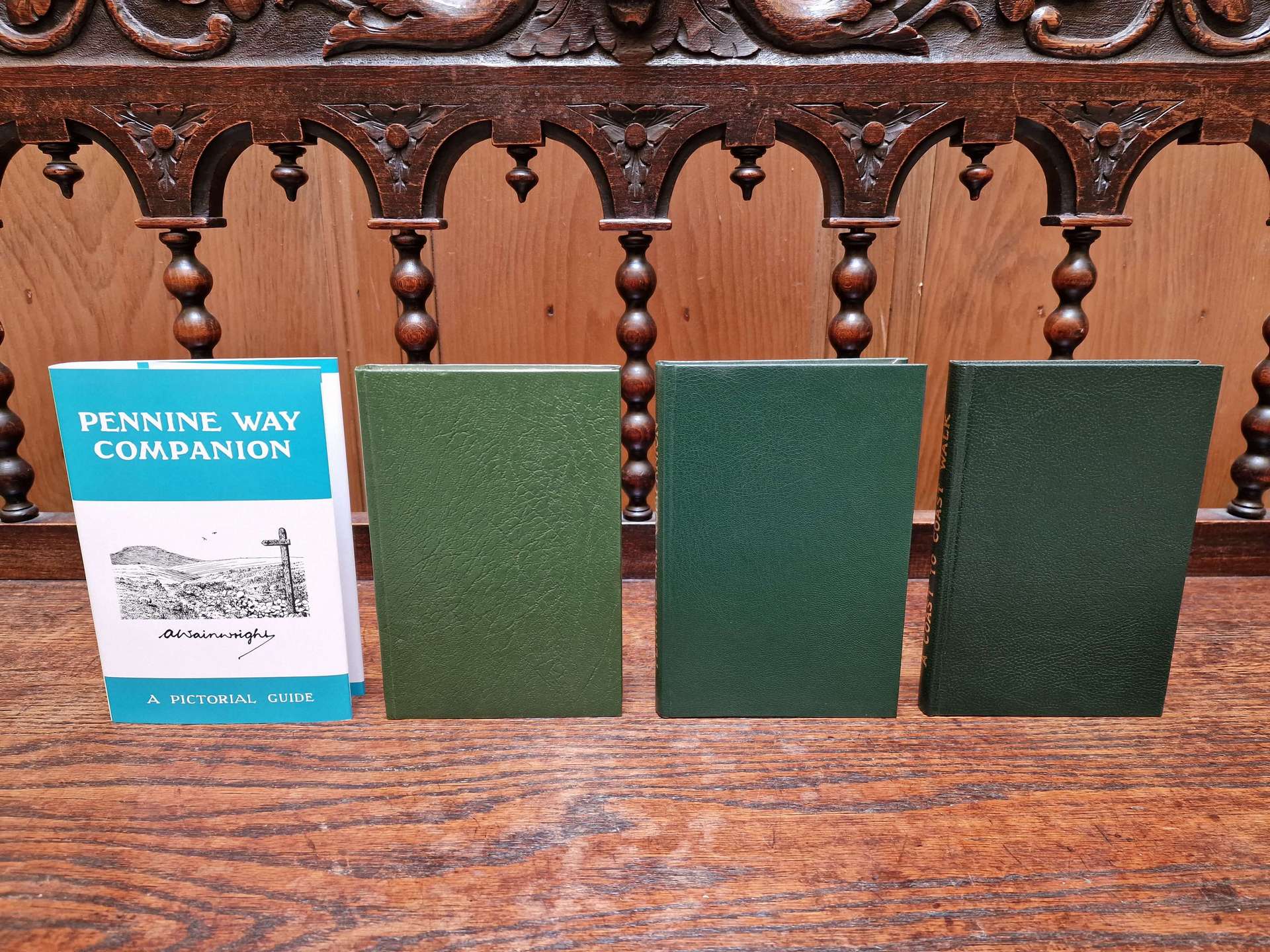
The Wainwright BBC TV series premiered in the North East in 1985 and made its national debut on 12 May 1986. The series featured a dedicated program focused on the Pennine Way, prompting the Gazette to bolster stock levels for this title and others in anticipation of heightened demand.

Towards the end of 1987, the Gazette ceased printing Wainwright books, and Local Printer Titus Wilson signed a four-year printing contract from 1988 to 1991. Andrew Nichol, the General Printing and Book Publishing Manager, was entrusted with overseeing all orders during this period.
Following Wainwright’s passing in 1991, the book publishing responsibilities transitioned to Michael Joseph. By the autumn of the same year, the entire transfer and handover process had been successfully finalised.

In anticipation of the book launch in April 1992, Michael Joseph forwarded new guidebook designs to David Rigg, the owner of Titus Wilson and Dixon Print. Chris Jesty, who would later revise the guides, personally handwrote the introductory prelim pages for the upcoming Michael Joseph editions.


The printing of the new Michael Joseph guides utilised the original negatives. The introductory pages and prelims were updated to align with the change in publisher while retaining the original prelims for historical continuity.


The outdated Pennine Way Companion dust jacket negatives were no longer suitable, prompting Titus Wilson to produce new ones. The negatives used to craft new dust jackets for Michael Joseph are presented here.





Michael Joseph’s new book launch proved successful, but the guidebook printing transferred to Clays Ltd in Suffolk shortly after. To ensure the security of the original materials, they remained in Kendal, and Michael Joseph received second-generation duplicates. This relocation was a purely business-oriented decision, although Titus Wilson was disappointed.
The guides needed updating, and Wainwright had granted Chris Jesty permission to revise them, but only after his passing. Regrettably, Michael Joseph was not inclined towards guidebook revisions, much to Chris’s dissatisfaction.
Despite initial reluctance, it became evident that specific inevitable route changes in the Pennine Way Companion needed addressing. Chris was granted authorisation to implement these minor alterations, leading to the publication of the Revised Edition in 1994. Three years later, a subsequent reprint replaced the trademark yellow pages with white paper to match the rest of the guide.
Michael Joseph implemented modest increases in guidebook prices. The 1992 launch guide sold for £8.99 and the subsequent 1994/7 revisions were priced at £9.99.
Chris was dissatisfied with Michael Joseph’s revisions. He aimed to create a comprehensive handwritten revision that mirrored Wainwright’s original work. The minor edits in the 1994 guide were typeset, resulting in less seamless integration with Wainwright’s handwritten style.

From left to right:
Pennine Way Companion, M. Joseph 1992
Pennine Way Companion (RE), M. Joseph 1994
Pennine Way Companion (RE), M. Joseph 1997

In February 1992, Michael Joseph was invoiced for 8,500 copies of the Pennine Way Companion. It’s remarkable to contemplate that over 30 years have elapsed since it left Kendal. Notably, it stands as the only guide that never made its way back to its Kendal origins.

In January 2003, Michael Joseph halted the publication of the guidebooks. In less than a month, Frances Lincoln successfully secured the bid to republish them. Wainwright’s artistic works’ homecoming to Kendal was a momentous occasion. However, it was regrettable that The Pennine Way Companion would not be included.
The Pennine Way Companion was eventually printed in Singapore in May 2004, with a retail price of £11.99. Subsequent reprints took place in Thailand in 2007 and 2009, priced at £12.99 and £13.99, respectively. Additionally, it was reintroduced as part of a clothbound box set published in 2009.
For reasons not entirely clear, the sales figures for this guide experienced a decline, with both Michael Joseph and Frances Lincoln achieving only three impressions each. While this raises questions, it may not necessarily indicate a decrease in the popularity of the Pennine Way itself. Other factors, such as changes in market preferences or promotional efforts, could have contributed to the observed trend.

From left to right:
Pennine Way Companion, F. Lincoln 2004
Pennine Way Companion, F. Lincoln 2007
Pennine Way Companion, F. Lincoln 2009
Thankfully, Frances Lincoln fully supported the guidebook revisions. Chris Jesty welcomed this news with delight, dedicating the next decade to the meticulous revision of the guides. He approached the task carefully, respecting Wainwright’s original work and making changes only where necessary.
Chris began fieldwork for the Pennine Way Companion – Second Edition in Middleton-in-Teesdale in May 2010. After dedicating numerous months to traversing this iconic trail, the revisions were finalised in January 2012.
In the summer of 2023, Chris revisited the Pennine Way at Teesdale, retracing his steps along the River Tees to Low Force, High Force, and Langdon Beck. This return marked his first revisit to these locations in 13 years.


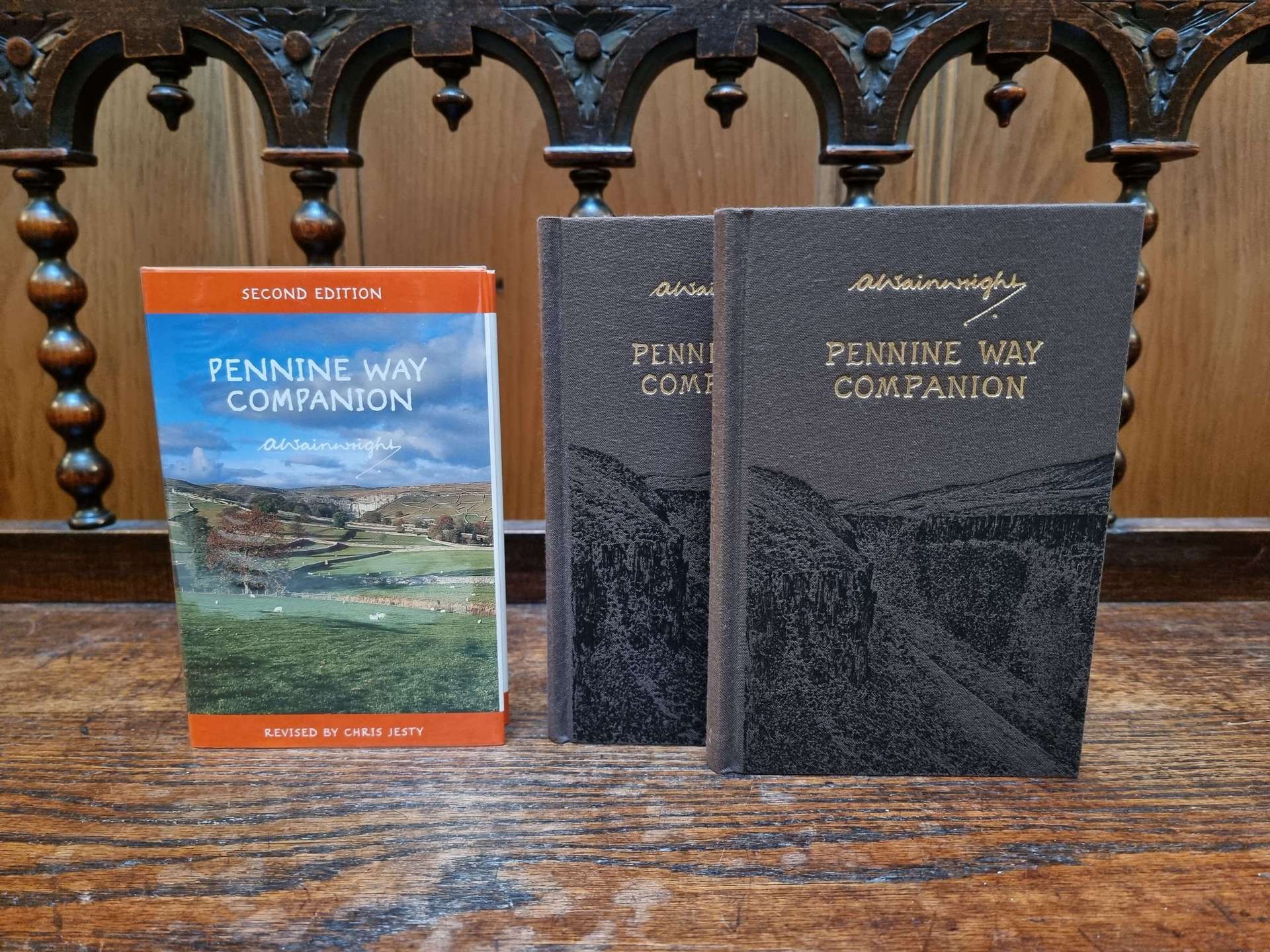
From left to right:
Pennine Way Companion (SE), F. Lincoln 2011
Pennine Way Companion (RE) low gsm paper, F. Lincoln 2009
Pennine Way Companion (RE) high gsm paper, F. Lincoln 2009
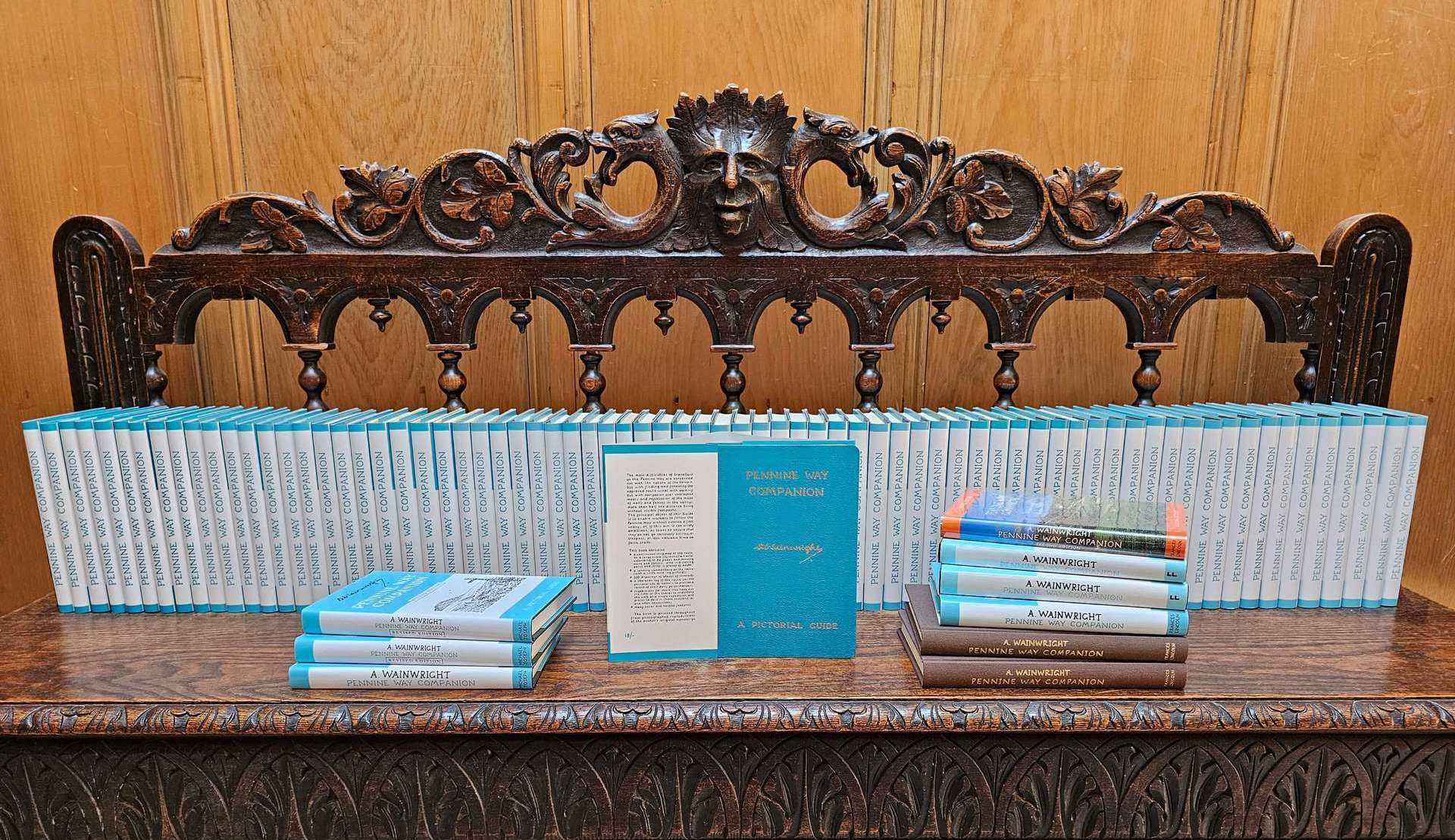
<<>>
Historically, the Pennine Way carried a negative reputation due to its numerous peat bogs, persistent rain, and extensive stretches of damp and desolate moorland. Despite these challenges, many embraced the opportunity to tackle the walk and the allure of a free pint at the Border Hotel, Kirk Yetholm, courtesy of Wainwright, serving as an irresistible reward for completing the journey.
My wife and I completed the Pennine Way in 2013, and this trail captivated our hearts. Journeying through its myriad iconic and breathtaking locations brought us great joy. The expansive moorland sections provided the perfect escape from civilisation and a profound connection with nature, where everyday concerns disappeared. Improved paths and increased accommodation options have enhanced the overall experience. I wholeheartedly recommend it to those not yet embarked on the Pennine Way. This unforgettable adventure will leave a lasting, positive imprint that will resonate throughout your life.
Back to top of page

